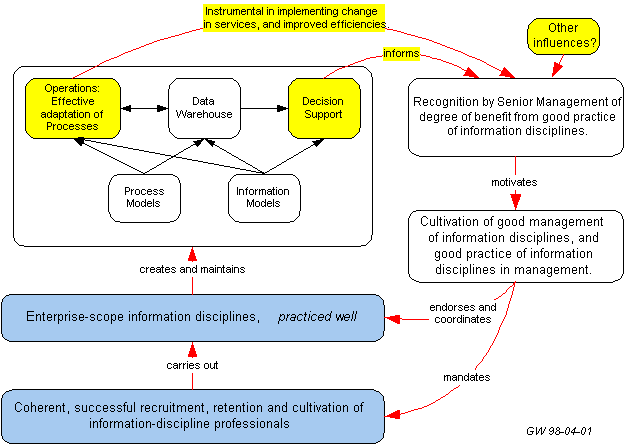Last edit: 05-03-17 Graham Wideman
| Last edit: 05-03-17 Graham Wideman |
Personal |
| The Big Question Article created: 98-07-17 |
Implications of Rapidly Changing Environment
SDSU is certainly not alone as an organization dealing with a rapidly changing environment:
To thrive in such times an enterprise needs to respond to external change with internal change.
The more traditionally structured organization values stability as a way to ensure that once the complex system of people are arranged to deliver the service or products, they continue to do so in a predictable way. If change is entertained, it is to make minor adjustments in a product or service, or adjust expenses or revenues by a few percent. Change is treated as an extraordinary event.
The new organization cannot afford such a slow pace of change. It must adapt rapidly, and it must do so intelligently, and perhaps in large jumps. This means that adaptation and intelligence must be built in to the enterprise -- retrofitted if necessary. But what does this mean?
Adaptation: An enterprise's products or services (internal or for external customers) are produced by processes -- and to adapt, these need to be readily changeable. To do this, processes must be deliberately designed, refined and changed, and the discipline which is equipped to do this using is the process-design branch of the information systems profession.
Intelligence: The enterprise must have accurate knowledge and internal communication about change in order to understand how to adapt fruitfully, and to attain the consensus needed to execute that adaptation. This requires the decision support and analysis branch of the information systems discipline, which will need to influence some aspects of existing and future operational systems.
So it seems clear that the information discipline needs to move from a supporting role (in local automation) to a prominent strategic role. This is hardly surprising since it is the information discipline that is powering much of the rapid external change in the first place.
And so the question arises:
In 1995, when I took on the Data Infrastructure Coordinator role, the implicit motivation was to try to develop the critical mass that would fuel the following self-perpetuating loop.

The hope, then, was that my efforts and those of my colleagues would have sufficient impact to alert senior management to the opportunities available in a disciplined approach to information at the campus-scope level, and that this would precipitate support (or popular demand) for full scale adoption of that approach. There was also some chance of an "outside influence" appearing with similar effect (for example, the arrival of the new president).
But what became apparent was that there was a fascinating fundamental conflict between the existing stucture and the information professions of today.
First, the information disciplines are not represented in management. The president, and all managers in the three major divisions at the vice president and director level have qualifications in disciplines other than information. In fact, there are almost no managers anywhere with information, process and systems analysis qualifications. (Though ironically, Information and Decision Systems is a specialty taught at SDSU.) This in itself is not extraordinary for a traditionally-structured paper-intensive organization.
The control of work processes, and the local automation systems that support them, are regarded by managers as their province, and they are generally devised and refined in the ad hoc way that would be expected of people unfamiliar with the process and system design principles and tools available in the information disciplines. In this setting, actual information professionals are regarded as "support staff", assigned to implement the ad hoc ideas. Since coordination of campus-scope developments is done in management-level forums (from which staff are generally barred), any campus-scope information issues are deliberated without professional information-discipline participation. (As a measure of the importance accorded the information and process discipline, one might note that in the last 18 years or more, no information professional managed to be promoted to any administrative position!)
This is not a terrible way to do business if change is slow and incremental. But such is no longer the case. With change more rapid, the gap widens drastically between what can be achieved with campus-scope professional attention to information and process in anticipation of change, compared to what is achieved without such discipline in ad hoc local attempts to react to change.
Our grassroots effort was intended to take advantage of existing operational systems, and not surprisingly had to contend with ongoing operational I.S. activity. But unfortunately this was not just slow-moving business as usual, but rather the turmoil of non-info-expert management reactions to sudden challenges (like the sudden appearance of the year 2000, and the sudden need to replace the accounting system).
So in actuality, as the need for professional information and process management increased over the last couple of years, the influence of non-info-expert management was exercised more, causing the systems picture to diverge away from coherence and undermining incremental attempts to bring discipline and order.
A Crisis to Solve the Problem?
The university is now pursuing an information sysems path that is, to say the least, challenging:
This is the situation that SDSU's de facto campus-scope information approach has led to. Though it I am sad to see it unfolding so, it is hard to imagine that a crisis (or at least a large budget fiasco) will be avoided. Perhaps that is for the best, as it may be the catalyst which precipitates a serious evaluation of SDSU's approach to leveraging the information disciplines.
[Back]